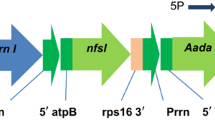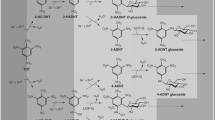Abstract
There is major international concern over the wide-scale contamination of soil and associated ground water by persistent explosives residues. 2,4,6-Trinitrotoluene (TNT) is one of the most recalcitrant and toxic of all the military explosives. The lack of affordable and effective cleanup technologies for explosives contamination requires the development of better processes. Significant effort has recently been directed toward the use of plants to extract and detoxify TNT. To explore the possibility of overcoming the high phytotoxic effects of TNT, we expressed bacterial nitroreductase in tobacco plants. Nitroreductase catalyzes the reduction of TNT to hydroxyaminodinitrotoluene (HADNT), which is subsequently reduced to aminodinitrotoluene derivatives (ADNTs). Transgenic plants expressing nitroreductase show a striking increase in ability to tolerate, take up and detoxify TNT. Our work suggests that expression of nitroreductase (NR) in plants suitable for phytoremediation could facilitate the effective cleanup of sites contaminated with high levels of explosives.





Similar content being viewed by others
References
Whong, W.Z. & Edwards, G.S. Genotoxic activity of nitroaromatic explosives and related compounds in Salmonella typhimurium. Mutat. Res. 136, 209–215 (1984).
Schnoor, J.L., Licht, L.A., McCutcheon, S.C., Wolfe, N.L. & Carreira, L.H. Phytoremediation of organic and nutrient contaminants. Environ. Sci. Technol. 29, 318–323 (1995).
Anderson, T.A., Guthrie, E.A. & Walton, B.T. Bioremediation in the rhizosphere. Environ. Sci. Technol. 27, 2630–2636 (1993).
Bizily, S.P., Rugh, C.L., Summers, A.O. & Meagher, R.B. Phytoremediation of methylmercury pollution: merB expression in Arabidopsis thaliana confers resistance to organomercurials. Proc. Natl. Acad. Sci. USA 96, 6808–6813 (1999).
Doty, S.L. et al. Enhanced metabolism of halogenated hydrocarbons in transgenic plants containing mammalian cytochrome P450 2E1. Proc. Natl. Acad. Sci. USA 97, 6287–6291 (2000).
Pavlostathis, S.G., Comstock, K.K., Jacobson, M.E. & Saunders, F.M. Transformaton of 2,4,6-trinitrotoluene by the aquatic plant Myriophyllum spicatum. Environ. Toxicol. Chem. 17, 2266–2273 (1998).
Bhadra, R., Wayment, D.G., Hughes, J.B. & Shanks, J.V. Confirmation of conjugation processes during TNT metabolism by axenic plant roots. Environ. Sci. Technol. 33, 446–452 (1999).
Thompson, P.L., Ramer, L.A. & Schnoor, J.L. Uptake and transformation of TNT by hybrid poplar trees. Environ. Sci. Technol. 32, 975–980 (1998).
Schneider, K., Oltmanns, J., Radenberg, T., Schneider, T. & PaulyMundegar, D. Uptake of nitroaromatic compounds in plants—implications for risk assessment of ammunition sites. Environ. Sci. Pollut. Res. 3, 135–138 (1996).
Harvey, S.D., Fellows, R.J., Cataldo, D.A. & Bean, R.M. Analysis of 2,4,6-trinitrotoluene and its transformation products in soils and plant tissues by high performance liquid chromatography. J. Chromatogr. 518, 361–374 (1990).
French, C.E., Rosser, S.J., Davies, G.J., Nicklin, S. & Bruce, N.C. Biodegradation of explosives by transgenic plants expressing pentaerythritol tetranitrate reductase. Nat. Biotechnol. 17, 491–494 (1999).
Bryant, C., Hubbard, L. & McElroy, W.D. Cloning, nucleotide sequence and expression of the nitroreductase gene from Enterobacter cloacae. J. Biol. Chem. 266, 4126–4130 (1991).
Guerineau, F., Lucy, A. & Mullineaux, P. Effect of 2 consensus sequences preceding the translation initiator codon on gene expression in plant protoplasts. Plant Mol. Biol. 18, 815–818 (1992).
French, C.E., Nicklin, S. & Bruce, N.C. Aerobic degradation of 2,4,6-trinitrotoluene by Enterobacter cloacae PB2 and by pentaerythritol tetranitrate reductase. Appl. Environ. Microbiol. 64, 2864–2868 (1998).
Wierzbicka, M. Comparison of lead tolerance in Allium cepa with other plant species. Environ. Pollut. 104, 41–52 (1999).
Coleman, J.O.D., BlakeKalff, M.M.A. & Davies, T.G.E. Detoxification of xenobiotics by plants: chemical modification and vacuolar compartmentation. Trends Plant Sci. 2, 144–151 (1997).
Cunningham, S.D., Berti, W.R. & Huang, J.W.W. Phytoremediation of contaminated soils. Trends Biotechnol. 13, 393–397 (1995).
Sambrook, J., Fritsch, E.F. & Maniatis, T. Molecular cloning: a laboratory manual. (Cold Spring Harbor Laboratory Press, Cold Spring Harbor, NY; 1989).
Gleave, A.P. A versatile binary vector system with a T-DNA organizational structure conducive to efficient integration of cloned DNA into the plant genome. Plant Mol. Biol. 20, 1203–1207 (1992).
Horsch, R.B. et al. A simple and general method for transferring genes into plants. Science 227, 1229–1231 (1985).
Acknowledgements
This work was funded by grants from the Defence Science and Technology Laboratory, the Biotechnology and Biological Sciences Research Council (BBSRC) and the Ministry of Defence.
Author information
Authors and Affiliations
Additional information
The online version of the original article can be found at 10.1038/nbt1201-1120
Rights and permissions
About this article
Cite this article
Hannink, N., Rosser, S., French, C. et al. Phytodetoxification of TNT by transgenic plants expressing a bacterial nitroreductase. Nat Biotechnol 19, 1168–1172 (2001). https://doi.org/10.1038/nbt1201-1168
Received:
Accepted:
Published:
Issue Date:
DOI: https://doi.org/10.1038/nbt1201-1168
- Springer Nature America, Inc.
This article is cited by
-
Non-contact biomimetic mechanism for selective hydrogenation of nitroaromatics on heterogeneous metal nanocatalysts
Science China Chemistry (2022)
-
Evolutionary aspects of the Viridiplantae nitroreductases
Journal of Genetic Engineering and Biotechnology (2020)
-
Toxicity of Explosive Effluent by Alliumcepa and Germination Test
Bulletin of Environmental Contamination and Toxicology (2020)
-
Genetic modification of western wheatgrass (Pascopyrum smithii) for the phytoremediation of RDX and TNT
Planta (2019)
-
Highly Sensitive Sensors for the Detection of Nitro Compounds Based on Pyrene Labeled Dendrons
Journal of Inorganic and Organometallic Polymers and Materials (2018)





